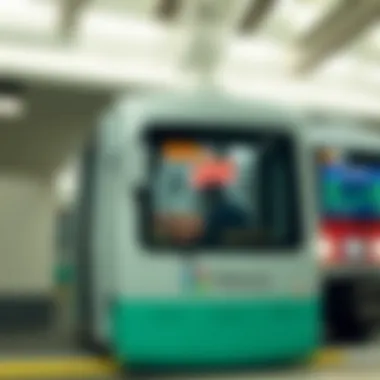Comprehensive Guide to Dubai Metro Operating Hours


Intro
Navigating the bustling city of Dubai requires an adept understanding of its transit systems, particularly the Dubai Metro. The metro isn't just a mode of transport; it’s a lifeline connecting the city's sprawling neighborhoods and business hubs. Knowing the operating hours of the metro can significantly impact traveling efficiency for various individuals, be it residents rushing to work, tourists hopping from one attraction to another, or investors aligning their schedules to view properties. This article delves deep into this crucial aspect, providing insights into the operating hours of the Dubai Metro and its broader implications.
Market Insights
The Dubai Metro plays an intricate role within the real estate landscape of the emirate. As more developments spring up around metro stations, understanding market trends tied to these hours becomes vital.
Current Market Trends
Recent years have seen a surge in property developments in areas adjacent to metro stations. Locations like Dubai Marina and Downtown Dubai are thriving, and much of this success can be attributed to accessibility via the metro. An interesting statistic to note is that properties located within a 500-meter radius of a metro station often see higher rental demand. Residents are increasingly favoring stations like Burj Khalifa/Dubai Mall, especially due to its proximity to high-profile destinations.
"Properties near metro stations often appreciate quicker than those far away, making them an attractive proposition for investors."
Property Value Analysis
Property values near metro stations tend to be buoyed by their strategic location. For instance, a unit at Emirates Towers commands a premium, given its seamless connection to the metro. This is evident when you cross-reference average property prices in the vicinity with the impact of metro accessibility. Furthermore, areas like Al Quoz are becoming hotspots for both residential and commercial markets, owing to the increased accessibility provided by the expanding metro network.
Commuter Traffic Patterns
Operating hours of the metro serve as a barometer of commuter behavior. During weekdays, the rush hours from 7 AM to 9 AM and again from 5 PM to 7 PM illuminate the heavy foot traffic that occurs around these stations. Understanding these hours can help potential investors predict peak rental seasons and times when properties might be in higher demand.
Investment Opportunities
With the metro’s operating hours intertwined with commuting habits, the potential for savvy investments in mapped-out neighborhoods either expands or contracts.
Emerging Neighborhoods
As the metro line expands its reach, neighborhoods like Dubai Silicon Oasis and Dubai Studio City are emerging as favorites among developers and investors. These areas, once considered peripheral, now benefit from significant infrastructure improvements and connectivity options provided by the metro. The allure of these locations often translates to more competitive rental yields and increased property value.
ROI and Rental Yields
The return on investment (ROI) in properties near metro stations tends to be robust. For investors, the key is to identify opportunities based on metro operation schedules and holiday variations. For example, rental yields in Dubai Marina range between 6% and 8% due to its accessibility and desirability, especially in peak tourism seasons when holiday operating hours are also extended. Understanding these nuances can lead to cultivating value-driven portfolios.
In summary, the operating hours of the Dubai Metro are more than just numbers on a schedule; they are intertwined with the very fabric of the city's real estate dynamics. As the metro continues to evolve, so too will the opportunities it creates for investors and residents alike. To keep abreast, it's wise to regularly check updates related to the metro through resources like Dubai Roads and Transport Authority and exchange insights on forums such as Reddit. Let these operational insights guide not only commuting plans but also strategic investments in a city that never stops growing.
Overview of Dubai Metro


The Dubai Metro stands as a monumental achievement in urban transportation, designed to serve a rapidly growing city that pulsates with energy and ambition. With the metropolis expanding by leaps and bounds, an efficient transit system like the Metro is not just a convenience; it's a necessity. This section lays the groundwork for understanding how the Dubai Metro operates, offering practical insights into its significance.
Historical Context
Launched in 2009, the Dubai Metro marked an essential step in the emirate's evolution. It's interesting to note that when plans were first unveiled at the turn of the millennium, there was skepticism regarding the need for such an extensive network. However, the city's skyline blossomed into a mix of glimmering towers and sprawling communities, quickly demonstrating the necessity for a reliable public transport system. The Metro was not just conceived as a transport option; it was envisioned to alleviate traffic woes and minimize the environmental impact of urban sprawl.
Key milestones in its history include:
- 2006: Groundbreaking for the Red Line commenced, representing a bold vision for urban connectivity.
- 2009: The first segment opened, making headways in changing the transportation landscape of Dubai.
- 2010: The expansion of the Green Line began, thus increasing access to key areas.
Now, as we seek to comprehend the significance of its operation hours, it’s vital to reflect on how the Metro system has shaped urban mobility since its inception.
Purpose and Significance
Understanding the operational framework of the Dubai Metro is essential for residents, investors, and anyone navigating the bustling city. It is a cornerstone for urban mobility, encouraging locals and tourists alike to utilize a system designed to be user-friendly and cost-effective.
Here are some critical purposes and significance of the Dubai Metro:
- Accessibility: Serves as a lifeline connecting vital districts, commercial hubs, and residential areas.
- Efficiency: Minimizes delays, allowing passengers to plan their journeys with certainty, which is crucial in a city known for its high-paced lifestyle.
- Urban Development: The existence of Metro stations has been shown to influence real estate values. Proximity to stations often increases property demand, making it a significant factor for investors.
- Environmental Adaptation: As a modern transit solution, it reduces the carbon footprint compared with individual car use, promoting a cleaner environment, which aligns with Dubai’s sustainability goals.
The Dubai Metro operates with precision, reflecting the emirate's commitment to innovation and quality public services. The operating hours are carefully crafted, balancing demand and ridership patterns to ensure the best commuter experience.
In summary, the overview of the Dubai Metro is not merely an exploration of its existence, but a deep understanding of its impact, growth, and integration into the daily lives of millions. This insight serves as a critical backdrop as we delve deeper into its regular operating hours, special adjustments, and how these factors shape the commuter landscape in Dubai.
Regular Operating Hours
Understanding the Dubai Metro's regular operating hours is fundamental for anyone navigating this bustling city, be it residents, investors, or visitors. The operating hours dictate not just when the system is available, but they also mold the daily routines of commuters and can significantly impact real estate trends in the region. With Dubai being a city that never sleeps, knowing when the Metro is in action helps individuals plan their activities efficiently.
Weekday Schedule
The weekday schedule of the Dubai Metro is crafted to accommodate the high energy of city life. Typically, the metro operates from 5 AM until midnight from Saturday to Wednesday, and it extends until 1 AM on Thursday nights. These hours are tailored to meet commuters' demands, allowing those heading to work or events to get around easily.
During peak hours, between approximately 7 AM to 9 AM and 5 PM to 8 PM, the frequency of trains increases significantly, with trains arriving every 2-3 minutes. For a city where time is gold, this efficiency is a significant draw. Commuters who rely on the Metro for their daily journeys experience reduced wait times, which makes it convenient for them to commute between business hubs and residential areas, enhancing productivity levels.
Moreover, understanding these hours allows commuters to avoid the rush, making their travel experience smoother and less stressful. One can grasp that timing is everything particularly in a high-paced environment such as Dubai.
Weekend Schedule
On weekends, the operating hours shift slightly, revealing a different side of the city’s rhythm. The Metro runs from 10 AM to midnight on Friday and 8 AM to midnight on Saturday. While these hours might seem limited compared to weekdays, they cater well to local residents who may prefer to start their day later or those indulging in leisure activities.


This adjustment also reflects a key insight into Dubai's social habits; Fridays are recognized as a day of rest for many, with cultural practices transforming the usual workweek dynamics. The weekend schedule still provides ample opportunity for enjoyment, allowing residents and tourists to explore the city’s iconic attractions without feeling rushed.
Traveling on weekends tends to be less hectic, an appealing factor for families and those eager to enjoy the attractions around the city, like Dubai Mall or Burj Khalifa.
In both weekday and weekend schedules, the efficiency of the Dubai Metro acts as a lifeline in the city’s transport network, fostering a system that continuously evolves in sync with the needs and lifestyles of its users. Regular operating hours not only ensure smooth transit but also reflect a city that is intimately connected to its community's rhythm.
Understanding the operation timings is essential for planning, whether one is investing in property or making day-to-day travel decisions.
Sources: Wikipedia, Britannica, Dubai Government.
Special Operating Hours
Special operating hours play a crucial role in the efficiency and adaptability of the Dubai Metro system. These hours allow the transit system to cater to specific needs beyond the usual schedules, providing an essential resourcing for residents and visitors alike. Given Dubai’s vibrant lifestyle and bustling events, understanding these special hours is not just a matter of convenience; it is a gateway to accessing a dynamic urban environment.
Holiday Adjustments
During public holidays in Dubai, the operating hours of the metro adjust to accommodate increased demand. For example, on occasions such as Eid al-Fitr or National Day, the metro usually extends its operational capacity. This is important because increased footfall can be expected as residents take part in festivities or travel to popular destinations.
- Extended Hours: The metro often starts earlier and closes later than usual on these days, allowing people to maximize their time enjoying the celebrations.
- Increased Service Frequency: Alongside extended hours, trains may run more frequently to handle the larger crowds, improving the commuter experience.
Understanding these adjustments can significantly enhance travel plans. For instance, knowing that the Dubai Metro runs longer during the holidays means relaxing and enjoying the festive atmosphere without worry about transportation back home. Effective communication through social media or the official RTA app ensures that travelers are well-informed.
Event-Specific Timings
Dubai frequently hosts various events, ranging from international expos to concerts and cultural festivals. During these special events, the metro runs on a modified schedule to facilitate access to venues, contributing to the overall success of the events. These event-specific timings can be instrumental in ensuring smooth transit for attendees.
- Frequent Trains to Major Events: The metro increases the number of trains on specific lines leading to event venues. This ensures that large crowds can be transported swiftly and efficiently.
- Altered Closing Times: On significant event nights, the metro may remain operational longer than usual, allowing attendees to leave without worrying about catching the last train.
These adjustments reflect the importance of public transportation in supporting a city's vibrancy and functionality. Investors and stakeholders in real estate should pay attention to this, as proximity to metro stations can be a major selling point for properties, especially during peak event times. By understanding the nuances of the operating hours, individuals can optimize their experiences within the city, whether they are commuting for work, leisure, or investment opportunities.
"Public transport systems like the Dubai Metro are vital to urban development, influenced significantly by operational timings that adapt to the city's rhythm."
For more insights on urban mobility and real estate dynamics, you can visit Wikipedia or the RTA official website.
Frequency of Services
When using the Dubai Metro, understanding the frequency of services is crucial for both efficiency in travel and the overall commuting experience. The Dubai Metro has designed its operations to accommodate a population that varies greatly in its transportation needs, thus creating a system where service frequency plays a significant role.


Peak Hours vs. Off-Peak Hours
Peak hours reflect the busy times of day, typically early morning and late afternoon when commuters are heading to and from work. During these times, trains run more frequently—often as short as every 2-3 minutes. This is typically around 7:00 AM to 9:00 AM and 5:00 PM to 8:00 PM. The higher frequency of service allows for greater movement of commuters in these crowded windows.
In contrast, off-peak hours see longer intervals between train arrivals, possibly stretching up to 10-15 minutes. During these times, it’s usually quieter and allows for a more relaxed commuting atmosphere. This variation in service frequency adjusts to ridership trends, making it responsive to real-time demand rather than maintaining constant train schedules throughout the day.
Impact on Commuter Experience
The frequency of services directly influences commuter satisfaction. For example, during peak hours, a longer wait can mean stress and overcrowded trains, which is certainly not ideal for anyone trying to reach a destination on time. Conversely, during off-peak periods, the availability of trains affords commuters the chance to travel with more comfort and space.
"Understanding peak and off-peak dynamics can greatly enhance how one navigates the Metro, saving time and reducing frustration."
Investors and developers also track these patterns closely. Locations with easy Metro access garner high interest among potential tenants and buyers due to the convenience and predictability of the transport service. Being near a Metro station can also enhance property value, particularly in areas where service frequency is deemed favorable.
Ultimately, the dual nature of service frequency—rapid during peak times and relaxed during off-peak hours—reflects a meticulously managed system that serves the diverse needs of a city like Dubai. For residents, visitors, and investors, being attuned to these schedules can significantly streamline travel plans and enhance overall mobility.
Operations and Management
The section on operations and management is central to understanding how the Dubai Metro system runs smoothly and efficiently. It encompasses the structural hierarchy involved in the metro's administration, strategy implementation, and maintenance. Good operations management ensures that the metro is not only a mode of transport but also a vital cog in Dubai’s infrastructural machinery, aiding the city’s growth. With such a complex network, several aspects contribute to its successful functioning, including the key authorities overseeing operations and the systematic maintenance schedules in place.
Authority Involved
In Dubai, the Roads and Transport Authority (RTA) is the primary entity that governs the operations of the metro. It’s a powerhouse making decisions about scheduling, budget allocations, and overall policy framework concerning public transport. The RTA works relentlessly to integrate the metro system into Dubai’s larger transport ecosystem, ensuring it aligns with developmental goals and urban planning initiatives.
Having a single governing body simplifies accountability and multi-departmental collaboration. It brings a streamlined approach to solving issues that could affect commuters, such as service delays or overcrowded trains during peak hours.
The RTA is not just about managing the metro; it aims to create a sustainable transport system that contributes to economic growth while enhancing the quality of life for residents.
The RTA also collaborates with various stakeholders, including civil engineering firms and transport consultants, to enhance the performance of the metro. This collaboration fosters an environment where innovative ideas can flourish, which is essential in a constantly evolving urban landscape.
Maintenance Schedules
Maintenance schedules are another critical aspect concerning metro operations. These schedules ensure that both trains and stations remain in excellent condition, giving commuters a dependable transit option. Regular maintenance checks are conducted to identify any wear and tear, ensuring safety and reliability are never compromised.
The maintenance routines are structured around:
- Daily checks: These include minor adjustments and inspections that are crucial for day-to-day operations.
- Weekly inspections: A more thorough examination of the train's systems and tracks ensures efficiency.
- Quarterly assessments and overhauls: These are intensive and involve significant upgrades and repairs to handle long-term wear.
By adhering to such a tight schedule, the metro minimizes disruptions in its services. For investors and travelers alike, these proactive measures translate into a smoother commuting experience. The right amount of foresight in maintenance planning significantly reduces the chances of unexpected delays or complications.
Sample Maintenance Schedule
- Phase 1: Daily inspections of critical systems (e.g., signal systems, emergency brakes)
- Phase 2: Weekly detailed reviews of the train's mechanical components
- Phase 3: Quarterly refurbishment of older trains with updated technology















